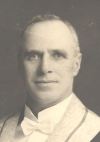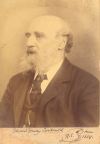(To view a copy of Edward Henry Corbould's will of 20 April
1900: click
here)
Edward Henry Corbould (b London,
5 Dec 1815; d London, 18 Jan 1905) was a painter, illustrator and
sculptor. He was a son of Henry Corbould. Edward Henry was a pupil
of Henry Sass (1788-1844) and a student at the Royal Academy, he
showed more wide-ranging interests than his father or uncle (George
James). He worked in watercolour and briefly in sculpture, winning
gold medals for both from the Society of Arts (Fall of Phaeton,
watercolour, 1834; St George and the Dragon, sculpture, exhibited
at the Royal Academy 1835; both untraced). He also designed monumental
figures for an unexecuted London County Council sculpture project
for Blackfriars Bridge (1889).
Edward Henry concentrated primarily
on watercolours of literary and historical subjects, which he exhibited
with the New Water-Colour Society from 1837 until 1898. His careful,
highly coloured and unmodelled style, compensated for by direct
and simple lighting of figures, was well suited to dramatising such
subjects as the Canterbury Pilgrims Assembled at the Old Tabard
Inn (1870; private collection), Canterbury Pilgrims enroute to Canterbury
(April 1873, private collection), Simond's Mill, Trompington [The Reeves Tale] (1883, private collection) and the prize-winning Plague of
London for the competition to decorate the New Palace of Westminster
(lithograph, 1849; London, British Museum).
Click here to see examples of Edward Henry's works.
Click
here to see details of Edward Henry's works related to the Canterbury Tales.
Edward Henry also prepared designs for new stamps,
following in his father Henry's footsteps. The sole work attributed to Edward Henry in the Henry Corbould collection of
works auctioned in
London in 1919 (auction lot 813) was purchased shortly after the auction by King George V for his philatelic
collection, since it was the basis of the first Mauritius stamps. The water
colour drawing and artist's instructions appear in Sir John Wilson's book The Royal Philatelic Collection published in 1952.
In 1842 Prince Albert, husband of Queen Victoria, purchased Edward Henry’s Woman
Taken in Adultery (British Royal Collection), and the artist was appointed Instructor
of Historical Painting to the Royal Family in 1851. He sketched the head and
shoulders of the dead prince in 1861, and in 1871 Queen Victoria commanded the
exhibition of his Marriage of Sir Nigel Bruce and Agnes of Buchan (untraced).
Shortly afterwards Corbould's contract with the royal family was terminated
for reasons that remain conjectural. Thereafter Corbould returned to exhibiting
at the Royal Institute of Painters in Water-Colours, supporting himself largely
by means of book illustration and by designing for the Illustrated London News
and other magazines. In his illustrations for Spenser (1853), Scott (1857),
Milton (1864), Spanish Stories (1870) and Tales of the Saracens (1871), he demonstrated
a stylistic adaptability but also, in his rather flattened figures of foreign
heroes and heroines, a tendency to anglicise his subjects.
Only occasionally working in oils, Edward Henry
painted in Kensington London a portrait of Mrs John Pritt Gardner of Longdon
Lodge near Rugeley. The painting is signed and dated June 1881 (private collection).
Other traced watercolour works in private collections
include:
The Dream c1840
The Poultry Girl 1842
Girl with Shrimp Net
1843
The Swoon c1870
The Orange Girl 1881
Astarte (Queen of the Morning
Star; Goddess of War) 1887
A second version of the painting of The Poultry
Girl, painted in 1851 and called The Butcher's Daughter, and with a more ornate
background than the 1842 version, was shown in a 1992 episode of the Antiques
Roadshow. More details can be found in part 4 of the BBC's printed magazine
The Antiques Roadshow Collection 1992. Click
here to see both versions of this subject side by side.
One of the houses in which Edward Henry lived is now included in the UK Attractions website. That particular house is at 52 Eldon Road, Kensington W2. Edward Henry also lived at 10 Hyde Park Gate W in the 1860s, when he was drawing master to the Royal Family, and at 7 Trebovir Road Earls Court SW during at least part of the two decades 1880s and 1890s. The Earls Court house is now a small hotel.
To Art + Artists |

Edward Henry Corbould c.1870

Edward Henry Corbould 1889 |